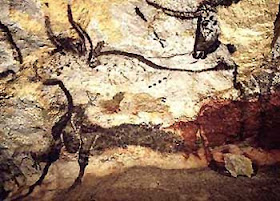Tuesday, 10 May 2011
THE AUROCHS
I thought it was about time for me to write about another ancient, extinct animal, so I chose the aurochs. Most of the cattle breeds we have on our farms today, such as Jerseys, Guernseys, Herefords, and Angus, are descendants of the aurochs, except smaller. Aurochses were really, really big cattle. At the shoulder, they were 6.6 feet tall, and they could weigh as much as 2,200 pounds. Hunting them, back in the days when people mostly used spears and arrows and other such weapons, was scary and dangerous. But whenever the hunters killed an aurochs, they had enough meat to feed the whole village, and maybe their dogs, too.
The aurochs probably started out in India, and then it spread out into other parts of Asia, Europe, and North Africa. In the beginning, there were tons of aurochs running around, but as the eons passed, there got to be fewer of them. By the time of Christ, there were aurochses only in Central and Eastern Europe. People kept hunting them so the range of the aurochs got even smaller. By 1300, only Poland, Lithuania, and East Prussia had any aurochses. And by 1400, these animals were only living in one part of Poland.
The king, princes, and dukes were the only Polish nobles who were allowed to hunt large game, and when the aurochses got to be few and far between, even the king stopped hunting them. By 1500, the aurochs was just living in the Jaktorowski forest, and the king asked the people in the nearby town of Jaktorów to protect the aurochs. In exchange for doing this, they didn't have to pay any taxes.
But the aurochs kept on disappearing. In 1564, there were only 38 of them left, and these looked weak and skinny. The villagers thought the aurochses were getting thin because they had to compete with domestic animals that roamed around the forest and fields, looking for food. So then the king made it illegal to let domestic animals graze where the aurochses were.
But besides the lack of food, the aurochses seemed to have some sort of disease that they caught from the local cattle. By 1602, there were only 4 healthy aurochses and several sick ones left, and in 1627, the last aurochs died. The Polish people kept her skull, but later on, when Sweden invaded Poland, they took the aurochs skull, and now it is in a museum in Stockholm.
The male aurochses were black, and they had a stripe along their spines. The females and calves were a reddish color. Mostly, these big cattle liked to live in wet, wooded areas. They could swim for short distances, like far enough to get to a nearby island. The aurochs used to live on Sicily, but they didn't have to swim there because there used to be a land bridge.
We think that the aurochs liked to eat green grass and leaves and sometimes fruit from trees. They had very aggressive temperaments, which is why primitive people thought it was a really big deal if you could kill one. There are lots of paintings in caves of the aurochs, and later groups of people also used the symbol of the aurochs bull in their culture.
Julius Caesar wrote about the aurochs in Gallic War, Chapter 6.28. He said they were "a little below the elephant in size, and of the appearance, color, and shape of a bull. Their strength and speed are extraordinary; they spare neither man nor wild beast which they have espied." Then he talked about how the Germans thought that men who could kill an aurochs were very brave. And also he said the Germans liked to use the horns of aurochses as cups to drink out of at banquets.
In the 1920s, there were these two German brothers who were zoo directors, and their names were Heinz and Lutz Heck. They decided to do something called "breeding back" to recreate aurochses. The idea with this is that if all the aurochs genes are still around, in modern cattle, the aurochs isn't really extinct. So they did a bunch of breeding, and they came up with a breed called Heck cattle. Or sometimes they're called "Recreated Aurochs" or "Heck Aurochs." There are several thousand of these cattle in Europe now, and they look sort of like what we think the aurochs used to look like. But they are not really quite the same genetically as aurochses. Also the Heck cattle have a pale yellow stripe on their backs instead of the white one like the aurochs had.
In Poland there is a group called the Polish Foundation for Recreating the Aurochs, and the scientists in this group want to use DNA from aurochs bones in museums to make a new aurochs. They think they will be able to do this, and when they have made some new aurochses, they can put them back in the forests of Poland, where they used to live.
So anyway, maybe someday the aurochs won't be extinct anymore. And if that happens, I hope all the new aurochses will stay in Europe and not come over here. And the reason I hope this is because I think the aurochs looks really big and scary, and I would not want to meet up with one, personally!








No comments:
Post a Comment